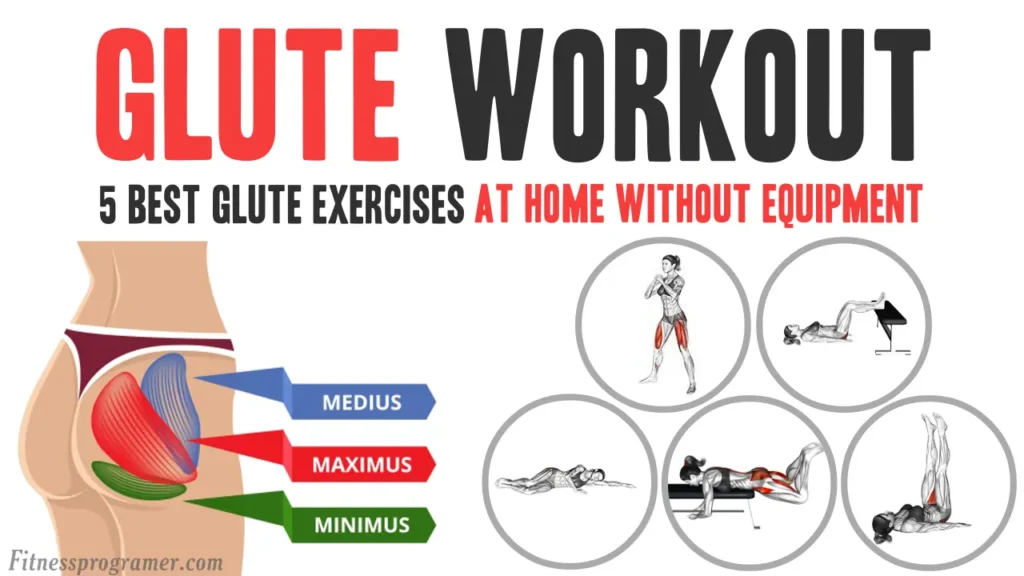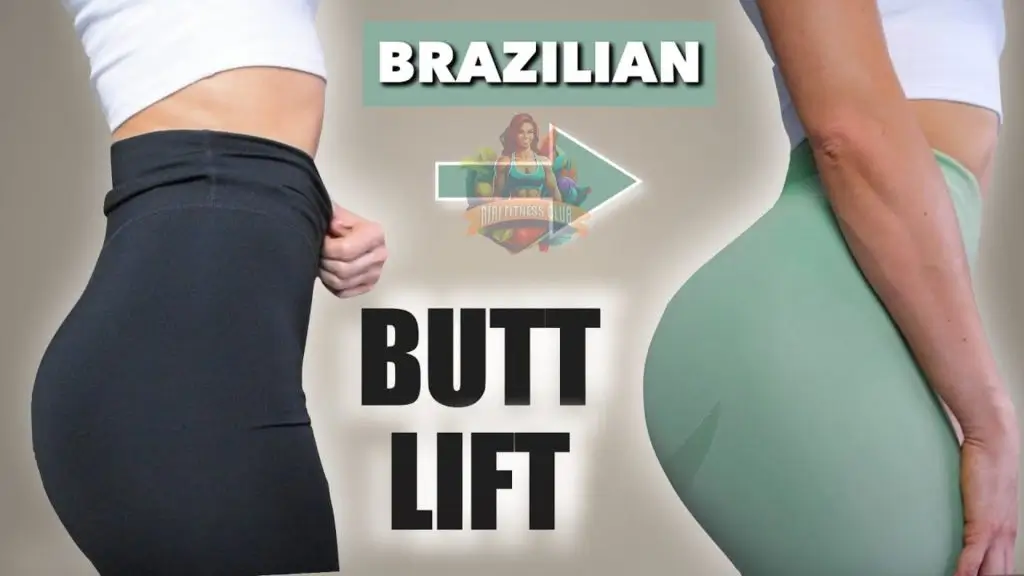5 Powerful Glute Exercises At Home Without Equipment
If you’ve ever felt like your workouts are missing something when it comes to sculpting your glutes, trust me; you’re not alone. The good news? You don’t need fancy gym equipment or endless hours on the treadmill to build strong, round, and functional glutes. With the right bodyweight exercises, you can make incredible progress right at home.
Today, I’ll share five of my favorite glute exercises at home without equipment. These aren’t random moves; they’re carefully selected because they target different areas of your glutes, giving you that full, lifted, and powerful look while also improving your overall strength and mobility.
Before we jump in, here’s what I want you to know: your glutes are more than just a “show muscle.” They’re the powerhouse of your body. They stabilize your hips, support your lower back, and help you move more efficiently in everything you do. That’s why training them properly is so important.
Below, you’ll find five moves that hit your glutes from every angle; plus tips to make them harder as you progress. Before we move on to the exercises, let’s review the glutes and then I’ll guide you step by step as if we were training together.
Anatomy of the Glutes: What You’re Really Training
The glutes aren’t just one muscle—they’re a group of three working together:

- Gluteus Maximus – the largest, responsible for hip extension and giving your glutes their shape.
- Gluteus Medius – located on the side, crucial for hip stability and balance.
- Gluteus Minimus – deeper layer, helps stabilize your pelvis.
The exercises below will hit all three so you get both aesthetics (shape and lift) and performance (strength and stability).
Why Train Your Glutes at Home?
When I work with clients, one of the first things they tell me is, “I don’t have time for the gym.” And that’s okay. You don’t need a gym membership to make progress. Training your glutes at home has several advantages:
- Convenience: No commute, no waiting for machines, no excuses.
- Consistency: You’re more likely to stick with it when the workout fits into your lifestyle.
- Effectiveness: With bodyweight resistance, you can still challenge your muscles by focusing on technique, control, and time under tension.
Your glutes respond just as well to bodyweight movements—if you train them smartly.
The 5 Best Glute Exercises Without Equipment
Now, let’s get into the fun part.
1. Bodyweight Sumo Squat
This move is one of my go-to’s for glute training at home. Think of it as a wide-stance squat that not only fires up your glutes but also works your inner thighs. By opening your hips and lowering deeper, you recruit muscles that a standard squat often misses. It’s simple, but it’s incredibly effective.
How to do it:

- Stand with your feet wider than shoulder-width apart, toes slightly pointed out.
- Keep your chest tall, core braced, and shoulders relaxed.
- Push your hips back and bend your knees, lowering as if you’re sitting into a chair.
- Keep your heels grounded and your knees pressing outward.
- Once you’ve reached your lowest comfortable position, press through your heels to return to standing.
Reps: 3 sets of 12–15 reps.
💡 Tip: Pause for a second at the bottom of each squat to really feel your glutes engage.
Why it works: The sumo squat shifts more load onto the glutes and inner thighs compared to a narrow stance. It’s a fantastic way to strengthen your lower body while improving hip mobility.
2. Side Lying Clam
This one might not look like much, but don’t underestimate it. The side lying clam isolates your gluteus medius—the small but mighty muscle that keeps your hips stable. The burn sets in quickly, which is exactly what we want.
How to do it:

- Lie on your side with knees bent at 90 degrees, feet stacked.
- Keep your head supported by your arm.
- Without moving your pelvis, lift your top knee while keeping your feet together (like opening a clam).
- Slowly lower the knee back down.
Reps: 3 sets of 15–20 reps per side.
💡 Tip: Place your hand on your hip to make sure your pelvis isn’t rocking backward. Once you’ve mastered the bodyweight version, add a resistance band above your knees.
Why it works: This exercise strengthens the glute medius, which is key for balance, hip stability, and even reducing knee pain. If you run, walk long distances, or struggle with wobbly knees during squats, this is a must.
3. Lying Thigh Fly
Here’s one you probably haven’t tried before. The lying thigh fly challenges both your glutes and your inner thighs, making it a great complement to the other moves in this workout. It’s a controlled, mindful movement that forces you to focus.
How to do it:

- Lie on your back with your legs extended straight up toward the ceiling.
- Rest your arms at your sides for support.
- Slowly open your legs out to the sides, as wide as your flexibility allows without straining.
- Squeeze your thighs and glutes as you bring your legs back together.
💡 Tip: If flexibility is an issue, start with a smaller range of motion and increase gradually. For more muscle engagement, try the banded variation, which involves adding a resistance band to your ankles or thighs.
Reps: 3 sets of 12–15 reps.
Why it works: By combining hip abduction and external rotation, the thigh fly engages both the inner thighs and outer glutes. This helps balance muscle development and prevents pelvic instability.
4. Bench Glute Flutter Kicks
People often think flutter kicks are just for the abs, but when you perform them off a bench, they become a glute-focused isolation drill. They’re surprisingly challenging and really hit the lower glutes. If you don’t have a bench, the edge of a sturdy chair or bed works just fine.
How to do it:

- Lie face down on a sturdy bench so your hips are just off the edge.
- Hold the sides of the bench for stability.
- Extend your legs straight and lift them to hip height.
- Alternate small, controlled up-and-down fluttering motions with your legs.
- Keep movements slow and controlled — avoid swinging.
Reps: 3 sets of 3×15-20 each side
💡 Tip: Keep the movement small and steady—avoid swinging. The tighter you keep your core, the more your glutes will do the work.
Why it works: The constant tension from holding your legs elevated activates your glutes and hamstrings, while the flutter motion recruits stabilizing muscles. It’s especially effective for rounding out the upper glutes.
5. Glute Bridge on Bench
If I had to pick only one move from this list, it would be the glute bridge. It’s hands down one of the best bodyweight glute exercises, and elevating your feet on a bench makes it even more powerful by increasing your range of motion.

How to do it:
- Lie flat on your back with your feet placed flat on a bench or sturdy chair.
- Bend your knees at about 90 degrees.
- Push through your heels and lift your hips upward until your body forms a straight line from shoulders to knees.
- Squeeze your glutes hard at the top for 2–3 seconds.
- Lower slowly and repeat.
Reps: 4 sets of 12–15 reps.
💡 Tip: Press through your heels, not your toes. If you feel this more in your quads or lower back, adjust your foot placement until you find the sweet spot in your glutes.
Why it works: The glute bridge isolates your gluteus maximus—the largest glute muscle. With the added height of the bench, you get a deeper stretch at the bottom and a stronger contraction at the top, which means greater activation and better results.
Sample 15-Minute At-Home Glute Workout
Combine all five moves for a quick but effective home glute workout:
- Bodyweight Sumo Squat – 3×15
- Side Lying Clam – 3×20 each side
- Lying Thigh Fly – 3×15
- Bench Glute Flutter Kicks – 3×15-20 each side
- Glute Bridge on Bench – 4×12–15
Rest 30–45 seconds between exercises. Repeat 2–3 rounds depending on fitness level.
Warmup Before Your Glute Workout
Before we dive into the main glute exercises, I want you to set your body up for success. Skipping the warmup is like trying to start a car on a freezing morning—it’ll still run, but not as smoothly, and there’s a higher risk of breakdown. Here’s a 5 minute dynamic warmup routine I recommend before doing the exercises I shared:




Tips for Maximum Results
- Focus on form: Quality reps matter more than quantity.
- Mind-muscle connection: Actively squeeze your glutes during each movement.
- Progression: As you get stronger, add resistance bands or hold each contraction longer.
- Consistency: Aim for 2–3 glute-focused sessions per week.
- Lifestyle support: Pair training with proper sleep, hydration, and protein intake for faster results.
Nutrition and Recovery for Glute Growth
Building glutes isn’t just about training—it’s about how you fuel and recover.
Protein and Macronutrients
- Prioritize lean protein (chicken, fish, tofu, eggs) to support muscle repair.
- Don’t neglect healthy carbs and fats for energy and recovery.
Rest and Recovery Strategies
- Sleep at least 7–9 hours per night.
- Stretch your hips and glutes post-workout to avoid tightness.
- Use foam rolling for faster recovery.



FAQs About Glute Training at Home
1. Can I grow my glutes with only bodyweight exercises?
Yes! With proper form, time under tension, and progressive overload, bodyweight training can absolutely build glute size and strength.
2. How long does it take to see results?
Typically, you’ll notice changes in 6–8 weeks with consistent training and proper nutrition.
3. Do I need resistance bands or weights?
Not at first. These exercises are effective on their own, but adding resistance bands later can speed up progress.
4. Can I do these exercises daily?
I recommend training 2–3 times per week to allow your muscles time to recover and grow.
5. Will glute training reduce hip dips?
While you can’t change bone structure, strengthening your glutes can create a fuller, rounder appearance.
6. Are these exercises safe for beginners?
Absolutely! Start with just your bodyweight and gradually progress before moving on to more intense glute exercises.
Conclusion: Build Strength, Shape, and Confidence
Here’s the truth: you don’t need a gym or fancy equipment to build strong, sculpted glutes. These glute exercises at home without equipment are simple, effective, and accessible for anyone—whether you’re a beginner or more advanced.
What matters most is consistency, good form, and a little patience. Train your glutes, fuel your body, and give yourself time to recover. Over weeks and months, you’ll not only see the physical changes but also feel the confidence that comes from building strength from the ground up.
Remember, your glutes aren’t just for looks—they’re your powerhouse. So take these exercises, commit to them, and let’s get to work.
5 Powerful Glute Exercises At Home Without Equipment Read More »





